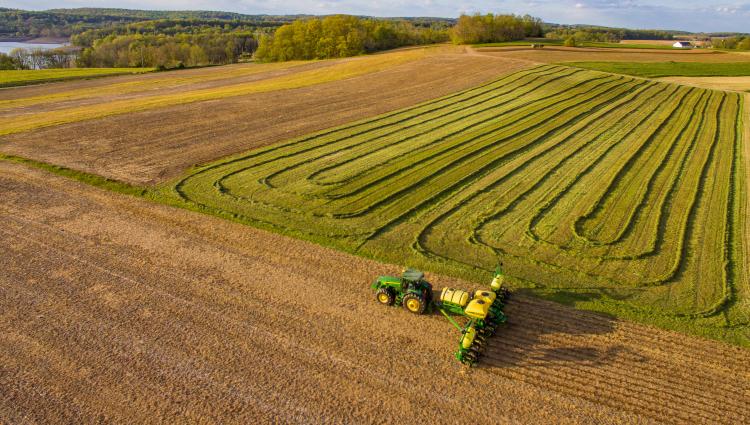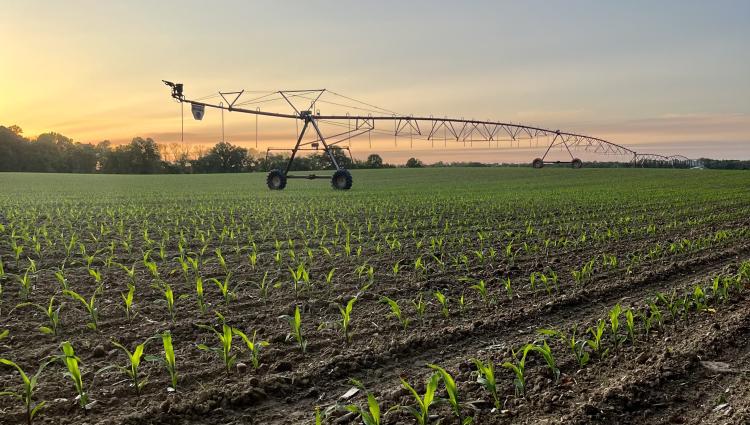Newsroom
Farm Credit Accepting Applications for 2024 Farmers on the Rise Award Program

Farm Credit is now accepting applications for its Farmers on the Rise program, which awards up to ten beginning farmers with $10,000 to grow their operations. The Farmers on the Rise award program honors outstanding beginning farmers within the diverse agricultural community who excel in their field.
“The Farmers on the Rise program recognizes the achievements of the next generation of agricultural leaders and empowers them to realize their dreams,” said Tom Truitt, Horizon Farm Credit Chief Executive Officer. “We are proud to support these farmers in their efforts to grow and innovate for the future of their operations.”
Farmers on the Rise award winners are selected based on their efforts in agriculture, financial character, leadership and community involvement, and environmental stewardship. The award program is open to beginning farmers who have at least three years, but no more than ten years, of farming experience.
“Each year, we are continually impressed by the exceptional quality of applicants,” said Johanna Rohrer, Horizon Farm Credit Member Education & YBS Program Manager. “Their passions and creativity are truly inspiring, and our panel of judges is eager to learn more about this year's applicants.”
This competitive award program is open to all open to Farm Credit customers and non-customers operating within the Association’s 100-county footprint. The deadline to submit an application is September 23 at 4 p.m.
For more information and to apply, click here. Contact learning@horizonfc.com or give a member of our team a call at 888.339.3334 with questions about this program or the application.
Please enter a valid password to access this page:
Wrong password. Try again!Newsroom
Building a Balance Sheet

Allison Beichner, Ag Relationship Manager and Phil Taylor, Ag Business Consultant
Knowing the financial position of your farm business is critical to its future success. One of the most important financial statements in helping you to understand the financial performance of your operation is the balance sheet.
A balance sheet measures your financial position at a specific point in time providing an overview of the equity position — also known as net worth — of your farm or business, in addition to cash investment. Equity is the owner’s personal investment in the farm or business as measured by the assets owned over the debt owed. A balance sheet showcases equity as current and noncurrent assets less current and noncurrent liabilities, and all are important components of a successful business. We'll get into the nitty gritty details of a balance sheet in this article.
Do I really need to complete an annual balance sheet?
Yes! Most farmers and business owners look at their cash position or year-end profit or loss as a measure of success, however, the cash position isn’t the only measure of business success. Completing a balance sheet allows you to see how your farm business’ equity has changed and grown from year to year by giving credit to adjustments for inventories, assets purchased and the change in liabilities throughout the year. Because a balance sheet shows a snapshot of your operation, it is recommended you prepare a balance sheet as of December 31 each year.
Other benefits of completing a balance sheet each year include:
- Improving your understanding of your business’ financial position, which allows you to make more informed management decisions on your farm for the future based on your equity.
- Lenders, such as Farm Credit, use this information to assess your business. Having a balance sheet completed can expedite loan approval when completed accurately and as of December 31 of each year.
- It demonstrates to your lender a greater initiative and interest in how your business performed from year to year.
- Information on the balance sheet can be used to calculate key financial ratios for your farm.
In addition to creating a balance sheet for your farm business, it is also recommended to complete a separate, personal balance sheet on your individual finances.
The Basics of a Balance Sheet
The three main components of a balance sheet are assets, liabilities, and owner’s equity. The standard accounting equation represented on a balance sheet is:
Assets = Liabilities + Owner’s Equity
Assets
Assets are anything owned by a farm business that has monetary value. Assets are classified as current and noncurrent.
Liabilities
Liabilities are anything owed by the farm business. Like assets, they are classified as current and noncurrent.
Owner’s Equity
Owner’s Equity is the area of the balance sheet that will need to be calculated since it is dependent on the value of your assets and liabilities. It shows what your business is worth as of the date of the balance sheet.
To calculate Owner’s Equity, subtract liabilities from your assets. The remaining value is Owner’s Equity.
Assets – Liabilities = Owner’s Equity
As a young and/or beginning farmer, it often feels as though progress moves slowly and business growth — and ultimately success — is not easily measured. Completing an annual balance sheet allows you to track the financial success of your business as net worth grows over time. Understanding the “change” in net worth is key. Is net worth increasing or decreasing? Why is it changing?
The goal is for net worth to increase each year because of the earnings generated by the farm business, not simply because assets were valued at a higher level. Take some time to fill out a balance sheet and compare it to one completed on December 31 of this year. Do this task for three years and then reference the first balance sheet you completed to see how far your business has come.
Want to see it explained a little easier? Check out this quick video! If you’re ready to try your hand at your own balance sheet, click here to download our balance sheet case study.
Please enter a valid password to access this page:
Wrong password. Try again!Newsroom
Beneficial Ownership Information (BOI) Reporting for Your Business
Reporting requirements have changed and this blog may no longer be accurate.
What is a BOI Report?
The Beneficial Ownership Information (BOI) report is a new type of report required by the U.S. federal government that discloses the owners of a business. Most businesses are required to file the BOI report with the Financial Crimes Enforcement Network (FinCEN) between January 1, 2024 and March 21, 2025. This report was created to help increase transparency of businesses and help fight illicit activity through the use of business structures. There are civil penalties if the BOI report is filed late and criminal penalties for willfully failing to file. BOI reports must be updated within 30 days if there are any changes, and businesses will be required to file an updated BOI if any information changes such as address, or the addition or reduction of owners. Read below to learn more about this report.*
*While our Business Services team can provide some guidance on this matter, specific questions on beneficial ownership and your potential requirement to file the BOI report should be referred to your legal counsel as our team does not file beneficial ownership information on a customer’s behalf with the Financial Crimes Enforcement Network.
Do I need to file a BOI report for my business?
The general rule is, if you filed documents with the secretary of state — or any similar office under the law of a state or Indian tribe — when establishing your business, you may need to file the BOI report. There are a limited number of entities exempt from filing. Here are some examples where you may not need to file a report:
- Sole proprietors doing business under their own name (no corporation or LLC)
- General partnerships (no filing done with secretary of state)
- Larger businesses and non-profit organizations*
- Highly regulated industries
- Examples include: publicly traded businesses, governmental authorities created by federal, state, or tribal governments, banks and credit unions, money transmitters, securities brokers and dealers, investment companies and advisors, venture capital fund advisers, insurance companies or producers, commodities brokers and dealers, public accounting firms, public utility companies, pooled investment vehicles, and inactive businesses
*For large businesses, you must meet all of the following criteria: over $5 million in gross revenue reported on the previous year's tax return and without any foreign-source revenue, business employs over 20 full-time employees in the United States, and have a physical office location in the United States. For non-profit organizations, you must meet one or more of the following criteria: an organization that received IRS approval for tax-exempt status under Internal Revenue Code section 501(c), a political organization that is tax-exempt under section 527(a), or an organization that is a trust under section 4947(a).
Who needs to be included on my BOI report?
See the table below for a timeline on filing your initial report and an updated report if changes are to occur.
| Established Date | Initial Report | Updated Report |
| Business entities already formed or incorporated before 1/1/2024 | Between 1/1/2024 and 3/21/2025 | Required within 30 days after any changes occur |
| Business entities formed or incorporated on or after 1/1/2024 OR 1/1/2025 | Within 90 days of receiving notice that their business entity was created or registered at the state level | Required within 30 days after any changes occur |
Who needs to be included on my BOI report?
On the BOI report, you must identify the company’s beneficial owners. A beneficial owner is any individual who, directly or indirectly, exercises substantial control over the reporting company or owns/controls at least 25% of the ownership interests of the reporting company. The following information on each company and each beneficial owner must be included:
| Company Information | Beneficial Owner Information |
| Full legal business name | Full legal name |
| Any DBA or trade name used by the business | Date of birth |
| Street Address of the company's primary place of business | Street address of current residence |
| The jurisdiction where the business was formed or registered | Identification number from a non-expired, government issued photo ID, along with the name of the issuing state (such as driver's license or passport) |
| The company's EIN (taxpayer ID number) | An image of the photo ID from which the identifying information was obtained |
What if I fail to file my BOI report on time?
Failing to file the required information through FinCEN by your required deadline could have significant consequences. Willfully failing to file or providing fraudulent information may result in a daily fine of up to $591, imprisonment for up to two years, or a fine of up to $10,000.
How do I prepare now for BOI filing?
While Farm Credit’s Business Services team can provide some guidance on this matter, specific questions on beneficial ownership and your potential requirement to file the BOI report should be referred to your legal counsel as our team cannot file beneficial ownership information on a customer’s behalf with FinCEN.
Here are some recommended “to-do’s” in preparation for filing:
- Review your list of business owners and key employees.
- Collect the Beneficial Owner personal information and make sure is up to date.
- Review your by-laws or operating agreements. You may need to add language that requires company’s beneficial owners to provide the business with required information.
Consult with your attorney for additional support in your by-laws and filing requirements. - Do your research at Beneficial Ownership Information Reporting | FinCEN.gov
- A reporting company can file online through the FinCEN BOI website at BOI E-FILING (fincen.gov)
If you have questions or need guidance on filing, a member of our Business Services team may be able to help. With increasing complexities in accounting, a member of our team may be the solution to your accounting and consulting needs. Visit our Business Services page to learn more or contact us today at 888.339.3334!
Please enter a valid password to access this page:
Wrong password. Try again!Newsroom
Farm Credit Awards $150,000 to New and Beginning Farmers

Horizon Farm Credit recently awarded $150,000 in grant funds to 15 new and beginning farmers through JumpStart, the Association’s competitive grant program for farmers in the start-up phase of business.
JumpStart is an annual grant program for agriculturalists with two years or less of farming experience, or those who plan to begin farming within the next two years. Grant funds can be used in various ways to support farm businesses. The 2024 recipients plan to use their funds to advance their operations through the purchase of items ranging from high tunnel systems that extend production cycles to irrigation systems, new infrastructure, and livestock handling equipment, among much else. Funds can also be utilized for services including legal fees, business planning, or other startup costs.
“Supporting beginning farmers is and always will be a priority at Farm Credit, and we’re proud to play a role in helping these individuals get started on their journey,” said Tom Truitt, Chief Executive Officer of Horizon Farm Credit. “These farmers are all uniquely talented, and one thing they share is their obvious passion for agriculture and ensuring its successful future. The funding provided by this grant program is a steppingstone for these new farmers to pursue their dreams and realize long-term financial success.”
The following applicants received grants valued at $10,000 to establish and grow their farms:
- Trenton Aitken of Follansbee, West Virginia
- Justin Belko of Wexford, Pennsylvania
- Bret Bucci Jr. and Trish Bucci of Sharptown, Maryland
- Andrew Burkholder of Chambersburg, Pennsylvania
- Andy Christman of Derry, Pennsylvania
- Frank Hamill of New Florence, Pennsylvania
- Elizabeth Krug of Dalton, Pennsylvania
- Jennifer Lauri of Sweet Valley, Pennsylvania
- Reges and Jean Magtibay of Westminster, Maryland
- Caleb Murphy of Greenwood, Delaware
- Matt Nowicki of Red Lion, Pennsylvania
- Becky Rockstroh of Freeland, Maryland
- Arthur "Carey" Saffelle III and Melissa Saffelle of Front Royal, Virginia
- Mitchel Smith of Shermans Dale, Pennsylvania
- Craig and Erin Swope of Canonsburg, Pennsylvania
More than 100 applications were received for the 2024 JumpStart grant program, all of which were carefully evaluated by a diverse panel of agriculture professionals and industry experts. Those named above were selected on the merits of their submissions, which included an application, business plan, and completion of the Ag Biz Basics educational course. Learn more about this program by visiting horizonfc.com/jumpstart.
Please enter a valid password to access this page:
Wrong password. Try again!Newsroom
Enabling Your Farm for the Future
by Joe Waddell, Director of Market Innovation, Horizon Farm Credit
With so many new technologies emerging for farms, it can be hard to sift through the noise of what you do and don’t need. New technologies are great, but many producers can still benefit from technology that has been on the market for some time, which can often be a more cost-effective option to provide profitability and success. While new technologies may provide additional insights and data that can drive further efficiency, older technology can have these capabilities too.
Before you start tracking every data point on your operation and integrating new products, you must examine and question your current processes, technology, and insights. Knowing your why and the unique story of your farm will help you realize what you’re doing, why you’re doing it, and how you can improve. You’ll then be ready to collect data that provides further insights into your farm, positioning you to influence those developing future technologies down the road.
Focus on Actionable Insights
Unsure where to begin? Data sets without insights are just a bunch of numbers. To truly benefit from this information, focus on actionable data such as:
- Yield data to help you understand which areas of your farm are most productive.
- Consumption rates to track how resources like fuel, water and fertilizer are being used.
- Turn times to monitor the efficiency of your equipment and processes.
Removing inefficiencies is key. Invest time and resources in tools that streamline your operations and provide a measurable return on investment, which doesn’t necessarily have to be monetary. By streamlining and automating tasks, or removing labor from the equation, you can save time and money. These types of efficiencies are low hanging fruit that can be realized through data examination.
Increase Your Aged Equipment's IQ & Prepare for an Upgrade
It may not be profitable for you to replace your current systems with new technology. However, you can enhance your current equipment and technology to work for you. Older equipment can even benefit from newer technology to allow an extended lifespan while adding new capabilities.
Tools like GPS, row clutches, and section control can significantly improve efficiency which can save fuel, other inputs — like seed fertilizer spray — and time. Adding new capabilities to older equipment also opens the door to variable rate nutrient applications, increasing operational efficiency far beyond the immediate benefits.
Up and coming tools that utilize actionable artificial intelligence (AI), like Farmwave, help reduce waste and improve efficiency of your existing legacy combines by better tracking header and crop loss real time, allowing you to make beneficial adjustments on the fly. When looking at older equipment and technology, think creatively about simple actions that can save you time and money.
Embrace Digitalization and the Next Generation of Technology
Once you lay the groundwork and gather key insights about your operation, you’re in a prime position to leverage the next generation of tools coming to your doorstep. To take advantage of AI and machine learning tools, you must provide sound data to the models. By having a solid baseline of historical data and information to feed to these tools, you can leverage the immense trend analyzing power these tools provide.
Start with simple digitization efforts and gradually move towards more complex systems. Focus on enabling technologies that increase operational efficiency before exploring disruptive tech. For example:
- GPS technology improves precision and efficiency in tillage, planting, spraying, and harvesting.
- Remote monitoring and connectivity tools from basic security monitoring cameras to application-specific products, like BinSentry, allow for constant oversight of your farm operations while freeing up manpower.
- Process improvement, inventory management and tracking tools, like One™ by Milc Group, allow you to be better control inventory, reduce waste, improve employee efficiency, and create more precise TMR rations.
At the end of the day, if you don’t question and examine what technology and data is telling you, you can’t learn from it or know how data benefits your farm and its unique story. When you leverage data available on your operation, you can enable your farm for the future with technology you already have and set yourself up to introduce new technology where it makes sense.
Have you integrated technology on your farm or made a change that’s been successful? I’d love to hear about it! Reach out to me at jwaddell@horizonfc.com to connect and share your story.
Please enter a valid password to access this page:
Wrong password. Try again!Newsroom
'Tis the Season for Acreage Reporting

Ralph Stickman, Crop Insurance Agent
Spring crop acreage reporting time is upon us! If you haven’t already heard from your crop insurance agent or received a copy of your Map-Based Acreage Report (MBAR), don’t hesitate to reach out and request your copies. These maps are invaluable tools to have with you in the tractor to record your planted acres and planting dates as you finish fields.
While reporting, keep in mind it is crucial that your planted acres and planting dates are correct. Accurate planting dates ensure you have the proper coverage for the year, and precise acreage reporting allows us to provide a detailed report of your coverage based on the acres and dollar amount per acre. Incorrect acreage can affect your total financial coverage and impact your production average in future years.
For example, a field traditionally reported as 100 acres based on maps might plant to 92 acres due to obstacles and changes made over the years. We need to know the actual number of planted acres, not just the field or boundary acres. Insuring the entire amount leaves you paying a higher premium than you should, and at harvest time, it spreads your production across more acres, resulting in lower production averages.
5 Fast Facts About Spring Acreage Reporting in the United States:
(per USDA)
- Mandatory Reporting:
- The United States Department of Agriculture (USDA) requires all farmers who participate in federal crop insurance programs to report their planted acres annually. This reporting is crucial for determining the extent of coverage and ensuring that claims can be accurately processed.
- Deadlines Vary by State:
- Acreage reporting deadlines vary by state and crop, but they typically fall between late June and early July. Missing these deadlines can result in reduced coverage or ineligibility for certain programs.
- Technology Integration:
- Many farmers now use GPS and other precision agriculture technologies to map their fields and track planting dates. This data can be directly integrated into MBARs, making the reporting process more accurate and efficient.
- Financial Impact:
- Accurate acreage reporting directly impacts the financial protection farmers receive. Underreporting can lead to inadequate coverage, while overreporting can result in unnecessarily high premiums and lower production averages.
- Compliance and Verification:
- The USDA conducts regular audits and verifications to ensure the accuracy of reported acres. Discrepancies between reported and actual planted acres can lead to penalties or adjustments in coverage.
When it’s time to review and sign your MBARs for the year, carefully review each yield line to ensure that planted acres and planting dates are correct. Remember, accurate reporting is not just a regulatory requirement; it's a critical step in protecting your livelihood and ensuring the stability of your farming operations. Reach out to your crop insurance agent today to ensure you’re on track with your acreage reporting. As always, our team is here to assist you through every step.
Please enter a valid password to access this page:
Wrong password. Try again!Newsroom
Horizon Farm Credit Announces 2024 First Quarter Financial Results
Horizon Farm Credit has announced its 2024 first quarter financial results. Net accruing loan volume for the first three months of 2024 was $6.6 billion, an increase of 6.7% compared to the same 2023 period. Net interest income for the first quarter of 2024 was $47.9 million, a 6.1% increase from the same period in 2023. Net income for the quarter was $32.7 million, a 4.4% decrease compared to the first quarter of 2023. The unfavorable impact of the 2024 first quarter results is principally related to a provision for allowance for credit losses recorded.
Nonaccrual loans increased $1.9 million in the first quarter of 2024 to $29.9 million, compared to $28.0 million at December 31, 2023, and decreased $4.2 million compared to $34.1 million at March 31, 2023. The Association’s nonaccrual loans as a percentage of total loans increased to 0.45% at the end of the first quarter of 2024 compared to 0.42% at the end of 2023, and decreased compared to 0.54% at the end of the first quarter of 2023.
“Horizon Farm Credit’s success is a direct reflection of our member-borrowers’ performance, and we are pleased to see continued growth,” said Tom Truitt, Horizon Farm Credit Chief Executive Officer. “Our mission is to provide consistent and reliable credit to rural America. We continue to be inspired by our members’ success, and we’re proud to support rural America as they make their dreams a reality.”
Members’ equity at March 31, 2024, totaled $1.2 billion — up 2.7% from December 31, 2023. Total Regulatory Capital Ratio was 15.84% as compared with the 10.5% minimum mandated by the Farm Credit Administration , the Association’s independent regulator. The Association paid a cash patronage distribution of $79.5 million to its member-borrowers in the first quarter of 2024.
For more information about the financial results and Horizon Farm Credit, visit horizonfc.com.
Please enter a valid password to access this page:
Wrong password. Try again!Newsroom
Crop Insurance 101: Replant Coverage Explained

Jessica Clarke, Crop Insurance Agent
As we've already seen a lot of wet weather this spring, many farmers in the mid-Atlantic are behind on their planting, which raises concerns about the upcoming growing season. Understanding replant, late planting, and prevented planting coverage in your crop insurance is crucial during such delays.
Know Your Options
During challenging planting seasons, it's essential to know what's covered by your Multi-Peril Crop Insurance (MPCI) policy to recover from losses. Here's a breakdown of the coverage included:
What is Replant Coverage?
Replant coverage applies if your planted crop suffers damage, and you plan to replant the same crop on the same acreage. This coverage may reimburse a portion of your replanting costs.
To qualify:
- Contact your agent and file a claim before replanting.
- Replant at least 20 acres or 20% of the unit acres.
- Do not plant before the Initial Plant Date (specific to county and crop).
- Catastrophic (CAT) coverage policies are not eligible.
We offer two types of replant claims: Regular (for over 100 acres per unit) and Self-Certification (for under 100 acres per unit). Claims can't be paid until you file your acreage report.
Do I Qualify for Late Planting Coverage?
This applies when you plant after the Final Plant Date (FPD). Coverage decreases by 1% per day during the Late Planting Period (LPP), becoming uninsurable if planted after this period. Dates vary, so contact your agent for specifics.
Can I File a Claim for Prevented Planting Coverage?
This applies if you can't plant due to an insured cause, like widespread weather events. You may receive a percentage of expected revenue.
To qualify:
- File the claim after the Final Plant Date or within 72 hours after the LPP.
- Plant at least 20 acres or 20% of insured crop acres.
- Acreage must have been planted in one of the last four crop years.
- Report Prevented Planting Acres on your acreage report.
Consult your agent about rules for planting a second crop after Prevented Planting and be sure to contact your agent immediately if you might face a Prevented Planting situation.
For personalized advice, it’s always best to consult your crop insurance agent directly. Detailed records of plant dates and acreage are essential for claims processing.
Farm Credit's crop insurance agents are ready to review your policy and discuss replant coverage and options. We're here to help you manage risk and gain peace of mind this planting season! Contact us today at 888.339.3334 or learn more here.
Please enter a valid password to access this page:
Wrong password. Try again!Newsroom
Farm Credit Distributing $79 Million to Members Through Unique Patronage Program

“Farm Credit’s cooperative structure allows us to share our profits with member-borrowers to significantly reduce their cost of borrowing, and this unique program distinguishes us from other lending institutions,” says Tom Truitt, Horizon Farm Credit Chief Executive Officer. “We’re proud to serve rural America and to be a trusted partner in providing reliable, consistent credit.”
Horizon Farm Credit is a part of the national Farm Credit System. Each Association determines its patronage payout, which is dictated by its total income, expenses, market conditions, and the Association’s bylaws. All patronage distributions are at the discretion of the Board of Directors, whose objectives are to ensure financial stability, fund future growth, and maximize returns to members.
“Patronage is a great benefit of being a Farm Credit member and we are very proud to be able to return this portion of our income to our members and communities,” says Brian Rosati, Horizon Farm Credit Chief Financial Officer. “We are committed to ensuring that the patronage program remains strong to support our members’ future successes.”
This year’s distribution will arrive to members in mid-April. To learn more about Farm Credit’s patronage program and to calculate your estimated patronage distribution, please visit horizonfc.com/patronage.
About Horizon Farm Credit
Horizon Farm Credit is a member-owned agricultural lending cooperative, providing consistent and reliable financing and related services to full- and part-time farmers, agricultural-related businesses, and rural landowners. The Association serves 100 counties across Delaware, Pennsylvania, and parts of Maryland, Virginia, and West Virginia. The Association has more than 22,100 members and over $6.5 billion in loans outstanding. Learn more at horizonfc.com.